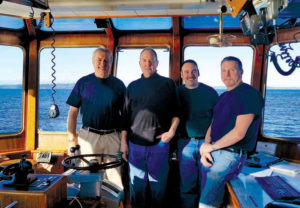Stop-Work Authority Equates to Empowerment to do the Job Safely

Caption goes in here
In this analysis hazards are identified, mitigating actions or engineered solutions are discussed, and actions are taken to eliminate identified hazards. The consistent application of this JSA process and other safety processes are important primary steps towards safe operations.
While processes are important for planning, the actual cornerstone of the execution of safe operations is the empowerment of our employees to stop work when it is not safe to proceed. This is known to our mariners as “Stop-Work Authority.”
Foss routinely delivers barge loads of material from the West Hylebos moorage area to various shoreside facilities in Tacoma. Recently, while making preparations to shift a cargo barge into one of these Tacoma terminals, crewmembers of the tug Henry Foss noticed significant residual cargo debris scattered along the barge walkways and throughout the areas on the barge where they would be working.
This debris presented a significant tripping hazard. Capt. Ryan Meyer and his crew Second Capt. Bill Archer, Chief Carl Balke and Deckhand Stop-Work Authority Equates to Empowerment to do the Job Safely; Congratulations to the Crew of the Henry Foss Boyd Rumbaugh called out the condition as not safe to work and made the decision to postpone the shift until the debris could be removed. They exercised their Stop-Work Authority.
Crewmembers politely asked the dock attendant to remove the debris and Capt. Meyer engaged the watch standers at the Fleet Monitoring Center in Portland, who worked with customer management to explain the situation and resolve the problem. The customer appreciated the concern for safe operations and was obliged to remove the hazards.
Meyer said he and his crew had observed the problem with the debris several times, “and it was getting worse and worse.” He added:
“We reached a point where using our Stop-Work Authority was the safest option to proceed with the job. The customer was very cooperative, so it was kind of a win-win situation all the way around. That was our first time to use the Stop-Work Authority and it was a very powerful tool.”
Often in the past, tug crewmembers would point out these types of hazards and leave it for management to deal with. This crew recognized that they are empowered to deal with hazardous conditions here and now, and they took the initiative to make sure the job could be done safely by utilizing Stop- Work Authority. Capt. Meyer and his crew exercised good prudent seamanship and demonstrated essential leadership in taking the initiative to assure safe operations.
